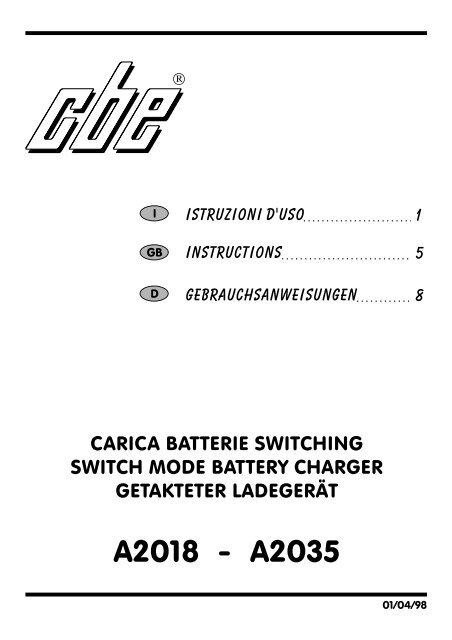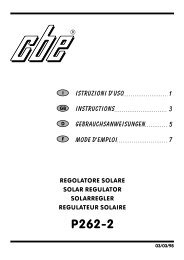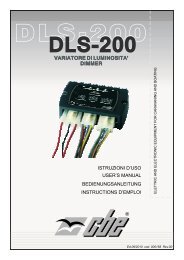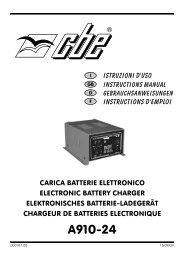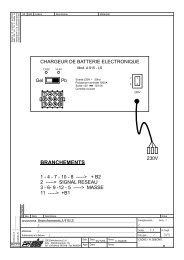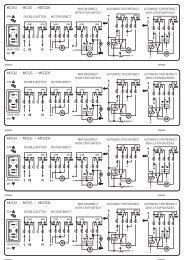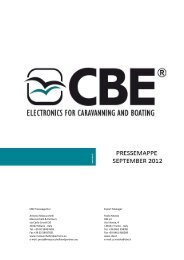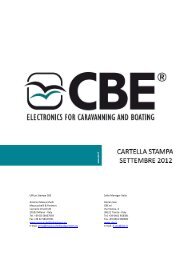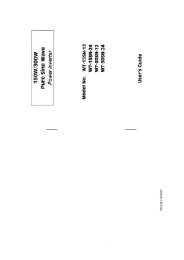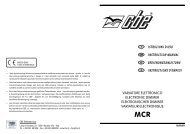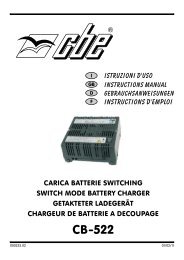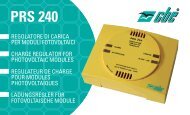A2018 - A2035 - Cbe
A2018 - A2035 - Cbe
A2018 - A2035 - Cbe
- No tags were found...
You also want an ePaper? Increase the reach of your titles
YUMPU automatically turns print PDFs into web optimized ePapers that Google loves.
LEGENDA1)Led di segnalazione fusibile: si accende quando il fusibile è guasto, solamente se è collegato uncarico alla batteria.2)3)Connettore per il collegamento del sensore di temperatura.Comando per il funzionamento con o senza il sensore di temperatura.NB: se non è collegato il sensore di temperatura posizionare su "O", diversamente il carica batterienon funzionerà.4)5)Comando per la scelta del tipo di batteria collegata: "Pb" batteria al piombo, "Gel" batteria al GEL.Led rosso di segnalazione della fase di carica (14,4V), led verde di segnalazione della fase dimantenimento (13,8V).6)7)8)9)10)Interruttore on/off di sicurezza.Terminale positivo per il collegamento della batteria.Terminale negativo per il collegamento della batteria.Cavo di alimentazione 230V.Segnale 12V 50mA, segnala che il carica batterie è collegato alla rete 230V.11)Fusibili di protezione uscita della batteria,- mod. "<strong>A2018</strong>" 1 fusibile 25A- mod. "<strong>A2035</strong>" 2 fusibili 25A.12)Presa d'aria con ventola di raffreddamento, funziona solamente quando il carica batterie è in fase dicarica.13)Sensore di temperatura della batteria (optional).Posizionare il sensore sulla parte superiore della batteria (utilizzando del nastro adesivo) e dove nonpossa essere influenzato da altre fonti di calore.LINEA DI CARICAIUoUV I14,5V13,8VC13,3VV AI Uo U UoV = Volt A = Ampere C = Carico - Loadt2
CONSIGLI E VERIFICHE PER L'INSTALLAZIONEIMPORTANTE:Non eseguire mai manutenzioni con la rete 230V collegata.In caso di anomalie rivolgersi ad un tecnico competente.CARICA BATTERIE- Installare il carica batterie in un apposito vano e fissarlo con le apposite viti.- Non ostruire la presa d'aria posta sul retro ed assicurare un'adeguata ventilazione.- Prima di scollegare l'apparecchio dalla rete 230V spegnere l'interruttore di sicurezza (rif. 6).- Il carica batterie può rimanere collegato permanentemente alla rete 230V in quanto sceglieautomaticamente il tipo di carica ed ha un ridottissimo autoconsumo.CAVI- Utilizzare cavi di adeguata sezione.- Non lasciare i cavi 12V e 230V nella stessa conduttura.- Proteggere i cavi da ogni possibile danneggiamento.BATTERIE- Controllare periodicamente il livello del liquido della batteria (batterie con acido).- Verificare il corretto serraggio dei morsetti di collegamento e togliere le incrostazioni di ossido.- Staccare il polo negativo per lunga inattività della batteria (oltre 1-2 mesi).FUNZIONIIl carica batterie switching serie A 2000, specifico per il settore camper e nautico, è in grado di caricarebatterie al gel (da stazionamento) o al piombo (da avviamento) in modo automatico.E' predisposto per il collegamento di un sensore di temperatura della batteria al fine di variare la tensioned'uscita e quindi prolungare la vita della batteria.La tecnologia switching ad alta frequenza permette di ottenere elevati rendimenti con pesi e dimensioniridotte.La carica avviene in tre fasi:- Carica massima: alla massima corrente, limitata elettronicamente, fino al raggiungimento di 14,4 V(25°C).- Fine carica: a 14,4 V (25° C) costanti per: 1h (Pb) , 6h 20' (Gel)- Mantenimento: a 13,8 V (25° C) costanti fino all'inserimento di un carico.3
CARATTERISTICHE<strong>A2018</strong><strong>A2035</strong>Alimentazione180 ÷ 250 Vac 50 ÷ 200 HzPotenza massima300 VA600 VARendimentoUscita termoregolata (con sensore temperatura esterno)86%13,5 ÷ 15,5 VccCorrente massima d'uscitaControllo correnteConsumo (rete 230V scollegata)18A0,02 mA35A0,04 mAControllo automatico fasi di carica- Carica massima- Fine carica- MantenimentoTipo di batteria (Pb o Gel)Sistema di carica25°C (0 ÷ +50)14,4V (15,6 13,6)14,4V (15,6 13,6)13,8V (15,0 13,0)Piombo - GelTamponeProtezione da sovraccaricoProtezione da sovratemperatura50 °CProtezione da inversione di polaritàInterruttore on/off di sicurezzaFusibile 12V di protezioneFusibile 230V di protezioneSegnalazione fasi di carica tramite LedSegnalazione fusibile guastoSensore temperaturaVentilazione forzataContenitore in alluminio anodizzatotipo auto 25Ainterno 3,15AOptionaltipo auto 25A x2interno 3,15A x2Collegamento alla rete 230VCollegamento alla batteriaCollegamento segnale reteSpina tipo "Schuko"Morsetti di bloccaggioTerminale faston 6,3Dimensioni (mm)Peso185 x 205 x 852 Kg370 x 205 x 854 Kg4
GBSPECIFICATIONS1)2)3)Fuse signalling Led: it go "on" when the fuse is broken, and only if a load is connected to the battery.Connector for the temperature sensor connection.Switch for operation with or without temperature sensor.NB: if the temperature sensor isn't connected make sure the switch is "O", otherwise the batterycharger doesn't operate.4)5)Switch for the choice of the battery type connected: "Pb" lead-acid, "Gel" GEL.Red LED indicating the recharge period (14,4V), green LED indicating the maintenance period(13,8V).6)7)8)9)10)On/off security switch.Positive terminal to connect to the battery.Negative terminal to connect to the battery.Mains cable (230V).Signal 12V 50mA, indicating the battery charger is connected to the mains (230V).11)Protection fuses of the battery,- mod. "<strong>A2018</strong>" 1 fuse 25A- mod. "<strong>A2035</strong>" 2 fuses 25A.12)13)Air outlet with cooling fan, operates only when the battery charger is in the charge period.Battery temperature sensor (optional).Place the sensor on the top of the battery (using PVC tape) and where it can be influenced by otherheat sources.CHARGING LINEIUoUV I14,5V13,8VC13,3VV AI Uo U UoV = Volt A = Ampere C = Carico - Loadt5
ADVICES AND CHECKS FOR THE INSTALLATIONIMPORTANT:Never make maintenance with mains 230V connected.In case of operational defects turn to a specialized technician.BATTERY CHARGER- Install the battery charger in a suitable place and secure it by screws.- Don't obstruct the air outlet on the back and assure a good ventilation.- Before connecting and disconnetting the battery chargers from the mains, switch "off" the securityswitch (ref. 6).- The battery charger can be always left switched "on" and connected to the mains because itautomatically chooses the charging cycle and it has a reduced autoconsumption.CABLES- Use cables of suitable cross section.- Don't lay 12V and 230V cables in the same cable duct.- Protect the cables from any possible damage.BATTERIES- Periodically check the battery acid level (lead-acid batteries).- Check the right tightening of the connection terminals and remove any oxide encrustments.- Disconnect the negative terminal of the battery when the vehicle is unused for long periods (1-2months).FUNCTIONSThe switching battery charger, designed for caravaning and nautical sector, can automatically charge"gel" and "lead-acid" batteries.It's predisposed for the connection of a battery temperature sensor in order to adjust the out voltage andthen to extend the battery life.The high frequency switching technology allows to get high performances with reduced weight and size.The system recharges the batteries in 3 phases:- Max. charge: at the max. current, electronically moderated, up to the end of charge value of 14,4V(25°C).- End of charge: to 14,4V (25°C) continuous for a time of: - 1 hour for lead-acid batteries, - 6 hours and20 minutes for gel batteries.- Maintenance: to 13,8V (25°C) continuous, up to a load connection.6
TECHNICAL DATA<strong>A2018</strong><strong>A2035</strong>Mains input voltage range180 ÷ 250 Vac 50 ÷ 200 HzMax. power300 VA600 VAEfficiencyHeat-regulated output (external temperature sensor)86%13,5 ÷ 15,5 VccMax. output currentCurrent controlConsumption (not connected mains)18A0,02 mA35A0,04 mAAutomatic control of charge cycles- Max. charge- End of charge- MaintenanceBattery type ("Lead-acid" or "Gel")Charge system25°C (0 ÷ +50)14,4V (15,6 13,6)14,4V (15,6 13,6)13,8V (15,0 13,0)Lead-acid - GelBuffer batteryOverload protectedOvertemperature protected50 °CInversion polarity protectedSecurity on/off switch12V fuse230V fuseCharge signalling by LED'sFuse signalling by LEDTemperature sensorForced coolingAnodized aluminium casecar type 25Ainternal 3,15AOptionalcar type 25A x2internal 3,15A x2230V connectionBattery connectionMains signal connection"Schuko" plugClamping lugsTerminals 6,3Dimensions (mm)Weight185 x 205 x 852 Kg370 x 205 x 854 Kg7
DZEICHENERKLÄRUNG1)LED Anzeige Sicherungen: es schaltet ein wenn die Sicherung kaputt ist, nur wenn die Ladung ander Batterie verbunden ist.2)3)Stecker für die Verbindung der Temperaturfühler.Befehl für die Funktion mit oder ohne Temperaturfühler.NB: Wenn die Temperaturfühler nicht verbunden sind auf die Posizion “0” geben, ansonstenfunktioniert das Ladegerät nicht.4)5)Befehl für die Wahl der verbundenen Batterie: “Pb” Bleibatterie, “Gel” Gel-Batterie.Rotes Led für die Anzeige der Ladungsfase (14,4V), grünes Led für die Anzeige der Erhaltungs-fase(13,8V).6)7)8)9)10)Schalter on/off für Sicherheit.Anschlußklemme positiv für die Verbindung der Batterie.Anschlußklemme negativ für die Verbindung der Batterie.Anschlußkabel 230V.Signal 12V 50mA, zeigt an daß das Ladegerät am Netz 230V angeschlossen ist.11)Sicherung für den Ausgangsschutz der Batterie,-Mod. “<strong>A2018</strong>” 1 Sicherung 25A-Mod. “<strong>A2035</strong>” 2 Sicherung 25A12)13)Lüftung mit Kühlflügel, funktioniert nur wenn das Ladegerät aufladet.Temperaturfühler der Batterie (Optional).Den Fühler auf die Oberfläche der Batterie posizionieren (mit Hilfe des Klebestreifens), und wo esnicht durch andere warmen Stellen beeinflußt werden kann.LADEKENNLINIEIUoUV I14,5V13,8VC13,3VV AI Uo U UoV = Volt A = Ampere C = Carico - Loadt8
RATSCHLÄGE UN KONTROLLEN FÜR DIE MONTAGEWICHTIG:NIEMALS Wartung durchnehmen bei 230V-Netzanscluß.Bei Störungen sich einer Fachkraft wenden.BATTERIELADEGERÄT- Das Ladegerät in einem eigens dafür vorgesehenen Raum mit den bezüglichen Schrauben montieren.- Die Lüftung auf der Rückseite nicht beeinschränken und eine geeignete Lüftung ermöglichen.- Bevor man das Gerät vom Netz 230V abschaltet, muß man den Schalter für die Sicherung abschalten(Bez. 6).- Das Ladegerät kann durchgehend am Netz 230V verbunden bleiben, indem es automatisch die Art derLadung wählt, und es hat einen sehr riduzierten Eigenverbrauch.KABEL- Kabel mit angepassener Sektion verwenden.- Nicht Kabel 12V und 230V in der selben Leitung lassen.- Die Kabel von allen möglichen Schäden schützen.BATTERIEN- Regelmässig die Batterieflüssigkeit überwachen (Bleibatterie).- Den Sitz der Klemmen kontrollieren und eventuell Oxydschichten entfernen.- Minuspol ausklemmen bei längere Nichtbenutzung der Batterie (mehr als 1-2 Monate).FUNKTIONENDas Ladegerät Switching Serie A 2000, speziell für den Caravan und Marinebereich, ist imstande Gel-Batterien (Verbraucherbatterie) oder Bleibatterien (Starterbatterie) zu laden.Es ist für die Verbindung eines Temperaturfühlers vorgesehen, um die Ausgangsspannung zu ändern unddas Leben der Batterie zu verlängern.Die Technologie Switching erlaubt bei hoher Frequenz eine hohe Leistung mit geringerem Gewicht undDimensionen.Die Ladung erfolgt in drei Fasen:- Maximale Ladung: bei maximalem Strom, elektronisch begrenzt, bis zu Erreichung der 14,4V (25°C).- Ende der Ladung: bei 14,4V (25°C) konstant für: 1h (Pb), 6h 20' (Gel).- Erhaltung: bei 13,8V (25°C) konstant bis zur Einfügung einer Ladung.9
TECHNISCHE DATEN<strong>A2018</strong><strong>A2035</strong>Netzeingangsspannungsbereich180 ÷ 250 Vac 50 ÷ 200 HzMaximale Leistung300 VA600 VAErtragAusgang termo-einstellbar (mit Außentemperaturfühlern)86%13,5 ÷ 15,5 VccMaximaler AusgangsstromStromkontrolleVerbrauch (Netz 230V nicht verbunden)18A0,02 mA35A0,04 mAAutomatische Kontrolle der Ladespannung- Maximale Ladung- Ende Ladung- ErhaltungArt von batterieLadungssystem25°C (0 ÷ +50)14,4V (15,6 13,6)14,4V (15,6 13,6)13,8V (15,0 13,0)Bleibatterie - GelbatteriePufferbetriebSchutz vor ÜberladungSchutz vor zu hoher Temperatur50 °CVor Verpolung geschütztSicherheitsschalter on/offSchutz Sicherung 12VSchutz Sicherung 230VLed-Anzeigen für die LadephasenAnzeige Kaputte SicherungTemperaturfühlerErzwungene LüftungGehäuse aus Eloxiertes AluminiumTyp auto 25AInneren 3,15AOptionalTyp auto 25A x2Inneren 3,15A x2Netzverbindung 230VBatterieverbindungVerbindung NetzsignalSchukosteckerKabelschuheKabelschuh 6,3Dimensionen (mm)Gewicht185 x 205 x 852 Kg370 x 205 x 854 Kg10
89/336 EMC73/23 e 93/68 EECI dati riportati nei fogli di istruzioni possono subire modifiche senza preavviso alcuno, questo è dovuto allecontinue migliorie tecniche. I disegni e i testi riprodotti sono proprietà della CBE. E' vietata la riproduzioneintegrale o parziale e la comunicazione a terzi senza l'autorizzazione scritta.Technical data on instructions sheets can be modified without notice, because technical improvementsare continually made. Design and texts are CBE property. Integral or partial reproductions are noadmitted as well as communications to third parties without written permission.Die in den Gebrauchsanweisungen geführten Daten können ohne Vorankündigung geändert werden, inZusammenhang mit den technischen Verbesserungen. Die veröffentlichten Abbildungen und Texte sindEigentum der Fa. CBE Jegliche Art von Vervielfältigung, komplett oder teilweise, ist ohne schriftlicheGenehmigung untersagt.Les données reportées dans les pages des instructions peuvent subir des modifications sans aucunpréavis ,ceci en vue des continuelles améliorations techniques. Les dessins et les textes reproduits sontde propriété de la CBE. La reproduction totale ou partielle et la communication à tiers, sans autorisation écrite sont interdites.Produzione apparecchiature elettriche ed elettroniche per caravaning e nautica.Manufacturer of electronic equipment for caravaning and nautical sector.Italy 38014 Gardolo TN - Lamar di Gardolo, 83 - +39 (0461) 991598 - Fax 960009URL: http://www.cbe.it - : cbe@cbe.it


